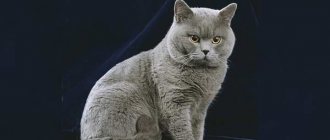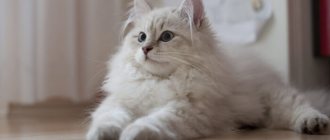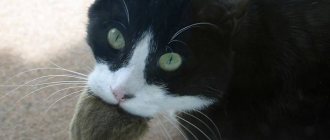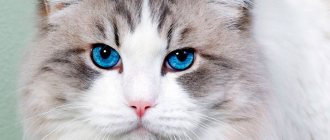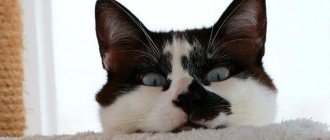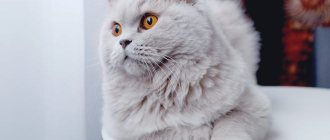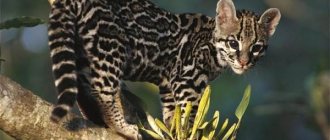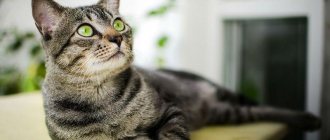Savannah
This animal amazes others with many of its characteristics, namely height, weight, etc. But the main surprise awaits those who decide to buy a kitten of this breed for themselves. The price is truly astronomical, although it is due to the fact that this breed has only 1 thousand individuals, and the first offspring were born only in the spring of 1986.
The basis of this breed was the domestic cat and the wild African serval. As a result, an animal was born, distinguished by its unique color, large ears, long legs, as well as fantastic jumping ability (up to 3 meters) and love for the water element. Savannah not only loves to swim, she is an excellent swimmer and is able to cover enormous distances across the surface of the water.
In addition, the Savannah has a developed intellect, she has an easy-going character and is devoted to her owner.
Photos of Scottish Fold kittens
Scottish fold cat with kittens.
Scottish fold kitten plays.
Scottish fold kitten scratches his hand.
Scottish fold kitten.
Scottish fold kitten.
Scottish fold kitten.
Scottish fold kitten.
Scottish fold kitten.
Scottish fold kittens Scottish Straight and Scottish Fold.
Scottish fold kitten.
Maine Coon
This breed rightfully takes second place in the list of the largest cat breeds. Representatives of this breed have a weight of about 15 kilograms and a rather menacing appearance. At the same time, they find a “common language” with both adults and children, without offending pets either.
These animals have a characteristic color and a powerful tail, like raccoons. Thanks to these features, the name appeared, which translated means “Mensky raccoon”. Maine is the name of the state in the United States where the ancestors of Maine Coons were once kept on farms.
The breed is practically devoid of disadvantages, with the exception of its astronomical cost. Cats are easy to train and always demonstrate nobility, intelligence, calm disposition and grace.
10 ABNORMALLY BIG CATS IN THE WORLD
Rex
The main distinguishing feature of Rex cats is their wavy fur. This feature appeared due to natural genetic mutations and was fixed through selection.
Varieties and appearance
There are three main types of rex.
Cornish Rex
Originally from England, Cornwall. The head is small, with pronounced cheekbones. The body is graceful, flexible, the limbs are long and slender. The guard hairs are very thin, the same length as the undercoat. Both types of fur curl in one direction, towards the skin.
Cornish Rex cats are particularly flexible and elegant.
Devon rex
The first individuals also appeared in England, in the county of Devonshire. The head is short and wide, with a strong chin. The body is muscular, with a broad chest. There is no outer coat, the guard hairs are longer and thicker than the undercoat. The waves of these types of wool are directed in different directions.
Cornish and Devonian are recognized by all major felinological organizations.
The Devon Rex's fur and undercoat are curled in different directions.
German rexes
The first animals were discovered in eastern Prussia. The head is rounded, with a pronounced chin and cheeks. The body is strong and strong, but not massive. Legs are thin, of medium length. The structure of the coat corresponds to the type of Cornish Rex.
German Rexes are recognized by FIFe, WCF and SCFF. The CFA is currently refusing to register them due to their being too similar to English types.
German rexes are strong and robust animals.
In addition to the main branches, there are two more young but promising rex breeds.
Selkirk Rex
A breed of American selection. The head is round and wide, with pronounced cheeks. Persian cats were used in breeding work, so the muzzle is slightly shortened. The body is rectangular, muscular, with strong bones.
The coat is thick, without topcoat, with large waves. Can be short or long. As a rule, kittens are born very curly. At about 2 months, the coat straightens, and starting from 8–10 months, it curls again.
The breed is recognized by ACF, WCF, CFA, TICA, ACFA.
The American variety of Rex quickly gained popularity
Ural rex
The first mentions of this aboriginal breed date back to the 40s. last century, but thorough breeding work began only in 1992.
The head is shaped like a short, wide wedge with pronounced cheekbones. The body is muscular, yet slender. The coat is of medium length, with very little outer hair. The curls are clear, without a specific direction.
Among the international organizations, the breed was recognized by the WCF.
The Ural Rex is an indigenous breed that has only recently attracted the attention of breeders
In addition, there are other, less common breeds of cats with wavy hair: Oregon, Tennessee, Missouri Rex, etc. Some of them are now in their infancy, others, having existed for some time, “dissolved” in the main branches or disappeared after cessation of breeding work.
Character
All rexes are famous for their friendliness and affection. These are pronounced companions who strive for human society and have a hard time enduring loneliness. Quite patient with children.
They strive for physical contact, and Cornish and Devonians prefer to sit not on a person’s lap, but on a person’s shoulders.
In childhood they are very active. With age, activity becomes more moderate, but rarely turns into laziness. They love heights and often climb to the highest points in the house.
Before purchasing such an animal, you need to take into account that many rexes are very “talkative” and often meow.
They are inquisitive, intelligent and can learn a number of commands and tricks. Some wear aport on their own initiative. Most quickly learn the rules of behavior in the house, although some can be headstrong.
German rexes especially quickly get used to the daily routine and often begin to wait for their owner at the door in advance. They are characterized by special neatness: according to reviews, many of them treat their toys very carefully and, after frolicking, independently take them to a secluded place.
Many rexes are sensitive to the mood of their owner and even try to console him if he is upset.
On the plus side, Devons are very affectionate and follow a person with their tail. And they are also very talkative, and not just Meow, but also MEAYAYA, Myak (short) or MEYak, my favorite sound is Ek (surprisingly short). You come home tired from work and Niba - say Ek! ...Eck! And it feels so good right away. When you eat, he unceremoniously climbs into your arms, and when you are just sitting somewhere, he will sit opposite you and Meow until you pat your knees and say “Niba, come here,” he runs, jumps up and sleeps. She can accompany the whole evening with her voice. I was cooking recently, and she was sitting opposite me - she opened her mouth and so on with an aspirated “K”. While I was cutting the salad, I started counting these “K”s 37 times without a break)
zvezdafur
https://irecommend.ru/content/devon-dobav-bezumiya-v-svoyu-zhizn
Features of care
The soft coat of the main rex groups does not require complex care. It is combed with a natural brush once every two weeks. Shedding occurs almost unnoticed, but at this time the frequency of brushing increases to once a week.
Some breeders recommend wiping animals with chamois every day: this helps maintain the shine of the coat and “keep the curl.”
Rexes are bathed approximately once every two months using mild shampoos for short-haired breeds. You cannot use a hairdryer for drying - due to hot air, the wool becomes brittle and loses its shine.
It is important not to overfeed the animal - due to their accelerated metabolism, rexes love to eat and often beg for more. There should be no poisonous plants in the house so that the pet does not get poisoned by tasting them.
Nails are trimmed about twice a month.
Photo gallery: rex
Rexes get bored alone, so you can get a companion for your pet
Baby rexes are very active
Rexes love to watch their owners and try to take part in all their affairs.
Rexes come in many colors
Female rexes are caring mothers
Chausie
It is considered not only one of the largest, but, at the same time, the rarest breed, the weight of which can reach at least 14 and a half kilograms.
The breed was born in 1990 and is a hybrid of an Abyssinian cat and a jungle cat. The jungle cat prefers to live in swamps, which is why it is also called the swamp lynx.
As a result of hard work, breeders managed to get a cat that has the power of a predator and the docile nature of a domestic cat. Chausie cats are quite strong cats, with an athletically complex body, a large (comparatively) head, large ears, and green or yellow eyes. Despite such external characteristics, the breed is devoted to its owner and feels great around children.
Turkish van
The Turkish Van is a rare domestic cat with semi-long hair, considered one of the oldest breeds of domesticated cats. This breed was bred on the basis of Van cats living in Turkey in the area of Lake Van. Animals reach their maximum by 5 years. Males weigh between 6–9 kg , females - from 4–6 kg . Their height is 35–40 cm, length from nose to tail tip is 90–120 cm.
They have a muscular, slightly elongated body, a massive neck and chest. The paws are of medium length, the hind legs are larger than the front ones, the pads are covered with hair. Fluffy ruff tail with transverse stripes. Wedge-shaped head, powerful chin, ears set high and straight, with inner feathering. Eyes can be the color of amber or copper, and can also be blue. Sometimes it happens that one eye is one color, and the other is another.
Silky coat of medium length and with a weak undercoat. Traditionally red and white (cream), but can be black and white (blue), tortoiseshell and white, or completely white. Moreover, the color must be at least 80% white.
Turkish Vans are very inquisitive and friendly, active and playful. They love water and water procedures and can even swim. They single out one family member as the owner and demonstrate their devotion in every way. They can be taught to walk on a leash and bring slippers. They get along well with other domestic cats and dogs, but they always try to dominate. Despite their willfulness, these are gentle and obedient cats. They love to play with children.
Ragamuffin
California is considered the birthplace of this breed, and it was born as a result of the efforts of Ann Baker, who decided to modify the Ragdoll. So she began to crossbreed the Ragdoll with other cat breeds, such as the Persian, the Yard Longhair, and the Himalayan.
As a result of these efforts, a breed was born that was called “cherub,” but at the last moment it was renamed and began to be called “ragamuffin,” which means “ragamuffin.”
Adults weigh at least 10 kilograms and acquire impressive sizes, although they mature only at 4 years of age. The breed does not have a beautiful, proportional physique, but it is distinguished by a variety of coat colors.
Elf
Elves are completely absent from the CFA rankings, since almost no one (except The Rare and Exotic Feline Registry) recognizes the breed. Breed standards have not yet been established; there are few breeders, breeding animals and kittens.
In Russia, the breeding of elf cats is carried out, in particular, by the Murmulet nursery. I decided to check with the nursery representatives whether the elf breed is registered in any cat association. Representatives of the Murmulet nursery responded that at the moment this breed is considered experimental, for this reason it is not available anywhere.
Nevertheless, elves are a new breed of hairless (hairless) cats that appeared in the United States at the beginning of the 21st century as a result of crossing the American Curl and the Canadian Sphynx. The fairy-tale name of these cats is due to their specific appearance: the cats have unusually folded ears (a legacy of the Curl).
The weight of such a cat is 4–8 kg, the skin color can be any, the almond-shaped eyes are blue or light brown. Elves have a special hanging belly, consisting of numerous folds.
Large ears with tips curled back give the face a fairytale appearance
Since the breed is very young, not all the character traits of this animal have been studied. Owners and breeders note that elf cats have so far proven to be calm, affectionate and intelligent. They communicate well with all members of the household, even with small children. They love to participate in all the affairs of the owner. The lack of fur imposes some restrictions: cats love warmth. The owners also noticed that elves can be vindictive - they do not forget grievances.
You can buy an elf kitten in the USA or in Russia (Murmulet, Magnificent nurseries), the average price for it is from 60 thousand rubles.
Video: Elf - a fabulous breed of cats
Kurilian Bobtail
The list of the largest cat breeds is replenished with another giant, since adult individuals can weigh at least 7 kilograms.
This breed of cats was once moved from the Kuril Islands to the mainland at the end of the last century.
The breed is distinguished by the original shape of its tail, which is quite short (only 8 cm maximum) and somewhat resembles a pom-pom. If a cat of this breed has a tail longer than 8 cm, then this is considered a fault of the individual, and if its length is only 12 cm, then the cat can be removed from the competition.
Kuril bobtails are not afraid of either moisture or frost, although they do not like to swim, but at the same time they are excellent at hunting fish.
The behavior of this breed of cat is somewhat reminiscent of the behavior of dogs, since they are very curious, are highly active and never refuse long walks and fun games, involving various toys, where they carry them in their owner’s teeth, like dogs.
Khao-mani
The Khaomanee is now recognized only by TICA, so it is not surprising that the breed is considered rare. At the same time, the Khao Mani is a very ancient breed, whose homeland is Thailand. The first mentions of kao-mani are found in literary sources of the 14th century.
“White gem” is the name of a cat of this breed translated from Thai. “White pearl”, “cat with silver and gold eyes”, “white jewel”, “diamond eye” - these are just some of the artistic comparisons that this delightful animal is rightfully awarded.
Kao-mani is in its infancy. The breeders of the breed can be listed on one hand: 4 official breeders are registered on the TICA website (and, for example, there are 24 registered breeders of Siberian cats).
An important point: the authenticity of the breed is confirmed only by a genetic blood test. Therefore, you need to understand that not all white shorthair cats are Khao Mani cats.
In general, representatives of the breed are distinguished by dazzling white short hair, shiny (diamond) eyes with a bright blue edging (heterochromia is also found, when one cat’s eye is blue and the other is yellow or green). The cat is small in size, weighing from 2.5 to 4 kg.
A distinctive feature of the kao-mani is its shiny eyes with a rim.
Kao-mani are prone to deafness, which also reduces the population of healthy animals involved in breeding.
There are few breeders of Khao Mani cats. There are a few in the USA and European countries. In this regard, buying a cat for breeding is very difficult and expensive. Even pet-class animals are an expensive pleasure that few people can afford. The average price of a kitten is 30 thousand rubles. For well-born and exterior individuals, the price can reach 100 thousand rubles.
Video: kao-mani cat
Norwegian Forest Cat
Due to the fact that the forest cat has long, fluffy fur, it seems that this animal is quite large. In fact, adults generally weigh no more than 9 kilograms.
There is a legend that this breed of cats was brought to Scandinavia by the Vikings in the holds of their ships. What these cats did on ships was to catch rodents, saving sailors from hunger and the bubonic plague, which was spread by rats.
In northern latitudes, cats became slightly domesticated, beginning to live next to humans. In 1934, the stage of breeding work with the Norwegian Forest Cat began, for which purebred representatives of this breed were sought throughout the world, as well as throughout the country. In 1976, the breed was officially recognized throughout the world.
The Norwegian cat is distinguished by its stable psyche; in addition, it is brave and strong, with the skills of a real hunter. These cats are not afraid to be with dogs that have the same easy-going nature, or near children. The Norwegian Forest Cat is considered to be one of the smartest.
The variety of redheads
Everyone is attracted to this color of optimism and joy that adorns their pet. Since a cat has more color variations, it passes them on by inheritance. Other tones that are given by ancestors also participate in the formation of coat shades. Upon careful examination, you will notice that any red color of cats does not look solid, but patterned. Although breeders work hard, it is impossible to genetically achieve the ideal tone to get rid of a tabby. But what beautiful variations you get!
White-red
The white and red cat is the owner of the most popular color. But it is worth taking into account the dominance of the white color gene, which is expressed in the desire to suppress white spotting of solid colors. Various forms of the same spotting gene, the partial spotting gene and the white recessive gene are included in the color work. And how bright the red-and-white kitten looks, which has become a brand of many famous companies.
Gray-red
A spectacular gray-red cat is obtained if the D gene is present, which is responsible for color saturation. This gene colors the coat red. The most spectacular color can combine red, gray and white shades. Such cats are rarely purebred, but they are no less loved and recognized.
Tabby red
The red color cannot be solid; marbled spots or stripes are always visible on the cat’s body. A tabby ginger cat is one of the main signs of a tabby - thin lines that clearly outline the upper and lower eyelids, forming the letter “M” on the cat’s forehead.
Red marbled
Marble color has many varieties. We can say that the red tabby cat is shading his tabby pattern. It is found in varying degrees of contrast in ginger cats. A heavily shaded tabby looks like a pure color. Medium shaded tabby is associated with marble stains, and weak blurriness shows the tabby more clearly.
Black and red
The color of a black cat with red spots is called tortoiseshell. A ginger kitten receives this rare combination of colors from its parents, who carry the genes for black and red coat pigmentation. Cats often turn out to be carriers of similar colors. This color is found in Maine Coons and Persians.
Siberian cat
According to some experts, the Norwegian cat and the Siberian cat have common ancestors. Despite this, the Siberian cat is distinguished by both intelligence and intelligence. Moreover, its weight can reach 12 kilograms.
These cats grew and developed in the conditions of the Far Eastern taiga, so they are absolutely fearless animals that are not afraid of their natural enemies.
The Siberian cat is not only smart, but also beautiful, and also not spoiled by selective artificial selection. She is an excellent example of a real hunter, as she is able to hunt even hares.
The Siberian cat has a calm and balanced disposition, which helps her find a “common language” with both adults and children. At the same time, she will easily show who is “the boss”, regardless of who is in front of her, a cat or a dog.
Cost of purebred gray cats
The price of purchasing a gray purebred kitten depends on its pedigree. Kittens from titled and eminent parents cost much more than ordinary representatives of the breed.
Let's take a closer look at the price of each breed:
- Persians. Kittens aged 1 to 4 months are estimated at 2000-3000 dollars. Adult representatives are much more expensive;
- Russian pigeon breed. These animals range in price from $1,200 and up;
- Angora cats. The cost of kittens of this breed can reach up to 600-700 dollars;
- Carthusian cats. These cats are valued by the international community at 500-1200 euros. Cats are much more expensive than cats;
- Nibelung. These kittens can be purchased for $1,000;
- British blue cats. The cost of one kitten can be $500 or more;
- Korat cats. The price of a rare breed starts at $500.
Kittens without documents are much cheaper than those whose pedigree is confirmed. Often, transporting an animal of an exclusive breed is estimated at the same cost as the cat itself. Famous and large nurseries charge higher prices than smaller businesses. Some gray kittens can be purchased second-hand through advertisements on the Internet.
British Shorthair
Thanks to its powerful body and short hair, it seems that this is a huge, strong cat, although in fact males weigh no more than 9 kilograms, and females - 6 kilograms.
The breed has an independent character and does not like pleasantries. She is able to endure prolonged loneliness, although she loves her owner very much and misses him if he is not at home. Because of its unobtrusiveness, it received a second name - “cat for a businessman.” He is wary of strangers and does not let them get closer than a couple of meters to him. If he wants, he can easily catch a rodent.
They accept affection only when they want it themselves, while demonstrating a sense of self-worth.
Breed card
| Characteristics of a cat | Notes | |
| General information | Reminiscent of British Shorthair cats. Unmistakable appearance thanks to the floppy ears | Folds and straights are born with ordinary straight ears, and only by the third week it becomes completely clear which is which |
| Character | Affectionate, calm, but still more active than the British breed | Easily adapt to a new place of residence and survive trips calmly |
| Appearance | Characteristic folded ears, round muzzle. Among the colors, bicolors are more common than others. They are a short-haired breed | It used to be believed that due to the unusual structure of the ears, kittens were often born deaf, but this is not true. |
| Behavior at home | Calm cats love to sleep on their backs with their paws spread out, or sit in funny positions | Treat children and other pets well and are not jealous |
| Care | Brush 1-2 times a week, more often during shedding Clean ears, as earwax accumulates faster | |
| Health problems | Folds cannot be crossed with each other due to the genetic transmission of bone and joint problems. The fold's partner must have straight ears, such Scots are called Scottish Straight | Scottish Straights have relatively recently become an independent breed. |
Pixie bob
This cat breed is considered a national treasure of the United States and its export is prohibited by law.
The breed was bred artificially. The breeders' task was to obtain a forest lynx that was not at all large in size. All that remains of the lynx are the tassels on the ears and unique colors, as well as a short tail. Adults weigh from 5 to 8 kilograms.
Despite the presence of lynx genes, these cats are distinguished by their calmness and love for their owner.
Main recognized breeds of shorthair cats
The first specialized exhibition was held in England in 1871. This moment can be considered the origin of felinology - a science that studies the anatomy and physiology of pets, breeding new breeds, and selection. We recommend reading the article about who a felinologist is.
Today there are many felinological systems in the world, they are mainly divided into two branches - American and European. Some sources provide information that there are currently two hundred and fifty-six cat breeds in the world.
TICA, the leading felinological organization in the United States of America and now the world, recognizes 73 breeds, including 52 short-haired animals.
The main European WCF system includes 70 breeds, of which about 50 are shorthaired.
Next, we will look at the main recognized and most famous shorthair cat breeds in the world in all systems. Breeds with short hair are certainly very beautiful, but there are other cats that are simply mesmerizing, with long hair and even hairless ones. We recommend reading the article about the most beautiful cat breeds on our Planet and looking at their photos.
Abyssinian
One of the oldest breeds in the world, originating naturally in 1882 in Ethiopia. The sorel is better known for its color - it is a small, flexible and agile animal of a bright, almost orange color. But there are four more colors - blue, fawn, ruddy and silver.
Sorel
Read about the Abyssinians.
Anatolian
The oldest cat appeared on the Armenian Highlands in the area of Lake Van. This is a short-haired variant of the Turkish Van. The main colors are chocolate, black, lilac, fawn, blue, cream, red, tortoiseshell, bicolor.
Also read about the Anatolian cat.
American Shorthair
Although the breed was recognized only in 1990, it originates from the oldest cats that came to America with the first settlers from Europe. In harsh weather conditions, her coat became coarser and thicker, and her size became larger. We are accustomed to its recognizable color - marbled tabby. Any colors except lilac and chocolate.
Read more in the article about American shorthair cats.
American Curl
A distinctive feature of any curl is its funny ears that are bent back. The breed was approved in 1981. Colors - any, except white and red point.
American Curl unusual black color
Read about American Curls.
American Bobtail
These animals first appeared in the United States of America in the fifties of the last century. They turned out to be the result of an unsuccessful attempt to breed a tailless snowshoe and received the name snow bean. Any colors and colors.
American Bobtail kitten
Read more in the article about American Bobtails.
Bengal Shorthair
Registered in America in 1983. This is a hybrid cat obtained by crossing a small Asian leopard (ALK - Asian leopard cat) and a regular domestic cat. Strong, muscular, with a unique shiny coat that is absolutely not subject to shedding. All colors of spotted and marbled tabby are gold, silver and snow. According to some reports, it is considered hypoallergenic due to the lack of undercoat.
Read about Bengals.
Bombay
An elegant, completely black cat, a real domestic panther, appeared in 1958, bred in the United States.
Read more about the Bombay cat on our portal.
British Shorthair
Known in Europe since 1880, the breed is of natural origin. The British dog comes in various colors and patterns, the most common and beloved is the blue coat color.
Burmilla
The breed was created in England by crossing a Burmese and a Persian chinchilla in 1981. Shaded colors of black, red, chocolate, blue, lilac, caramel and apricot.
Read about Burmilla.
Havana
A chocolate and lilac solid cat with green eyes, bred in Great Britain in the fifties of the last century.
Read more about Havanas.
Devon Rex
Known in England since the sixties of the twentieth century. Like any Rex, it has curly fur. Its color and color can be any.
More interesting and useful information about Devon Rex.
European Shorthair
The Celtic breed (synonymous with the European Shorthair) was registered in Europe in 1981. Bred from ordinary street cats. Any colors - solid, tabby, bicolor, smoke. Colors: black, red, blue, for a solid color - also white.
Egyptian Mau
A street cat brought from Egypt was crossed with an Italian domestic cat. Although registered in the United States only in 1977, it is a direct descendant of the ancient Egyptian cat. The color is only spotted tabby in tin, bronze, and smoky colors.
Read about the Egyptian Mau.
Kanaani
Hybrid wild Libyan cat. The breed was born in Israel already in this century.
Caraquet
An amazing hybrid of wild Caracal was registered in 2007 in the United States of America, and in 2014 in Russia. A very large cat, similar in appearance to its progenitor, up to fifty centimeters tall at the withers, weighing up to fifteen kilograms. One of the most expensive and largest in the world.
Read about the Caraquet hybrid breed.
Korat
The natural breed, formed in Thailand, has been known since the seventeenth century. Color - solid blue.
Read about Korat cats.
Cornish Rex
The first representative of the curly breed got its name from the wavy Rex rabbits. The line was developed in the fifties of the last century in Great Britain. Any type and color of color is allowed.
Read about Cornish Rex.
Kurilian Bobtail
The tailless large animal has been known on the Kuril Islands since the eighteenth century. The breed was officially recognized only in 1995 by the European system. Smoky, solid, two-colored, spotted “Kurils” come in a variety of colors - black, red (red), blue, cream, white, tortoiseshell.
Laperm
A funny cat with curly sheep's fur was born in the United States of America in 1982. Available in all colors and colors. White alpaca cats are adorable.
Read about lapermas.
Manx
The cat without a tail has been known on the Irish Isle of Man since the sixteenth century. The breed began to be officially recognized in the twenties of the last century. Any colors and colors are allowed.
Read about Manx.
Munchkin
A strong cat with a fighting character and short paws, bred in the USA in 1983. Its limbs are divided into three types: standard, ultra-short and dwarf (mei-toy). The kangaroo cat, as it has long been called, is allowed in all colors and patterns.
More about munchkins.
Mekong or Thai Bobtail
This breed is descended from the color-pointed tailless cats of Asia. She is called a living legend of the east. According to legend, the rings of the daughters and wives of the Sultan were strung on the tail of this cat, which has incredible curves, while bathing. Very similar to the Siamese, only with the original small curved tail or without it at all.
Read about Mekong Bobtails.
Oriental Shorthair
This cat line was bred in England in the fifties of the last century. “Space Alien” with huge ears comes in solid, smoky, tabby and any colors.
More in the article about orientals.
Ocicat
Bred in the USA by crossing Siamese, Abyssinian and American Shorthair cats to obtain the tabby color characteristic of wild predators. The breed was registered in 1964 and comes in twelve different colors.
Pixie bob
Registered in the United States of America in 1995. Pixie is a “fairytale elf”, bob-cat is a North American lynx. A large spotted cat with a short tail and tufted ears has a fairy-tale character and the appearance of a forest predator.
Read about pixie bobs.
Russian blue
This animal is rightfully the pride of Russia, along with the Siberian cat. The charming cat, known in the Arkhangelsk province since the sixteenth century, practically became extinct during the years of Russian revolutions and wars. He returned to his homeland only in the nineties of the twentieth century. The only color allowed is solid blue. One of the most popular breeds in the world because of its luxurious coat and wonderful character.
Read about Russian Blues.
Savannah
A hybrid obtained from crossing an African Serval and a Bengal. One of the most expensive and today the largest in the world.
A social animal with the appearance of a wild ancestor. Only tabby in several color options (golden, cinnamon, brown, chocolate).
Read more in the article about savannas.
Selkirk Rex
This amazing cat with wavy fur was registered in the USA in 1987. Comes in all colors and colors.
Read more about the Selkirk Rex.
Siamese
A cat that came into the world from Siam (modern Thailand). Known since the thirteenth century. From this ancient breed many of the new modern lines have descended.
Pets with a unique appearance and character come only in color-point color - with a characteristic mask on the face, paws and tail darker than the main background. The color variations are varied - sial point, red point, blue point, chocolate and lilac points, color, tabby, torty and tabby torty points. The eyes of a special oriental cut are always blue.
There are many legends about this cat. The most famous one clearly characterizes the temperament of the Siamese. Allegedly, this animal appeared from the union of a monkey and a lion, inheriting the lion's fearlessness and antics of the macaque.
The “Lunar Diamond of Siam” gave rise to such breeds as Burmese, Oriental, Himalayan, Neva Masquerade, Javanese, Snowshoe and many others.
Singapore
Stray cats in Singapore gave rise to this breed, which was registered in the United States in 1975. These graceful pets have ticked tabby coats.
Snow-shoe
“Snow Shoe” is the poetic name given to the descendant of a Siamese and an American shorthair cat. The pet in snow “slippers” has an affectionate character, which quickly allowed it to gain recognition among lovers of these animals.
One of the rarest, quite expensive and complex cat lines was registered in the United States of America in the sixties of the last century. It has a mitted color - a light background with dark spots, in different color combinations - sial, chocolate, blue (gray-blue) and lilac.
Soukok or sokoke
This is a natural breed of smooth-haired cat, probably no less ancient than the Siamese. Discovered in Kenya by American felinologists only in the seventies of the last century.
It received its name from the area where its first representatives were found. Its original wild color is called soukok-tabby.
Read more in the article about the Sokoke breed.
Thai
This is the most common variety of Siamese. The blue-eyed beauty has a more rounded body, with short hair in the same colors and patterns.
Read about Thai cats.
Toyger
This cat appeared in America in the nineties of the twentieth century. In fact, this is a “defective” Bengal, the spots and rosettes on its coat merge into stripes, forming a peculiar brindle color. This effect was reinforced by matings with other breeds.
Usually larger than its parent, with an independent character. Quite a rare and expensive animal. Color: tiger mackerel only.
Read about toygers.
Tonkinese
Obtained in the fifties of the twentieth century in America by crossing Burmese and Siamese breeds. A very beautiful graceful animal has a unique, unique only to this line, color “mink” in color variations of natural, champagne, red, blue, platinum, cream, fawn, honey.
Chartreuse
This natural breed, named after the province of Chartres, has been known in France since the seventeenth century. It was probably brought on trade ships from Syria or Africa. Solid blue color. Calm, fairly large, balanced animals with the habits of a dog.
Scottish Fold or Scottish Fold
Known in Great Britain since 1961. Obtained as a mutation of the British Shorthair. Characterized by soft ears with tips curved forward, as if hanging. The Scottish Straight variety has straight ears.
Read about Scottish folds on our portal.
Chausie
A hybrid obtained by crossing the House swamp wild cat and the Abyssinian cat. One of the most expensive, rare and large breeds. The weight of the male is up to sixteen kilograms.
The exotic animal was registered in the United States of America in 1995. Color - solid ticked tabby wild colors, sorel and black grizzly (black with a gray tint).
Exotic Shorthair
Brought out in America in the sixties of the last century. The exotic was purposefully bred as a Persian with short hair. The colors are numerous and varied.
Japanese Bobtail
Japanese cats with short tails (tailless) have been known since ancient times. Solid and tabby colors in different color options.
Read more in articles about Japanese bobtails.
Javanese
The Javanese was born almost simultaneously in Europe, Canada and America in the seventies of the last century. Selection was carried out to obtain different colors of the Balinese cat. The result was eventually identified as a separate breed.
It is believed that this pet is well suited for people prone to allergies.
A little more about the red color
In psychology, the orange hue is a symbol of optimism and sunny joy. Since a positive attitude and fun can work real miracles, cats of this positive color can even cure those who have undergone a complex operation, hypertensive and hypotensive patients, as well as those who often suffer from migraines.
If you believe the signs, the arrival of a red cat in the house will attract wealth and all material benefits. They say that some businessmen specifically have such pets to attract the necessary finances into their business.
Another well-known sign is that a ginger cat adds brightness to the personality of its owner, comparable only to its red fur.
Persian
Persian cats are among the most beautiful in the whole world. Their main difference is a snub nose and a flattened muzzle, as well as short but strong limbs and a long silky coat.
Persians like to remain silent and rarely speak up. These peaceful and aristocratic pets have won the hearts of many cat lovers.
